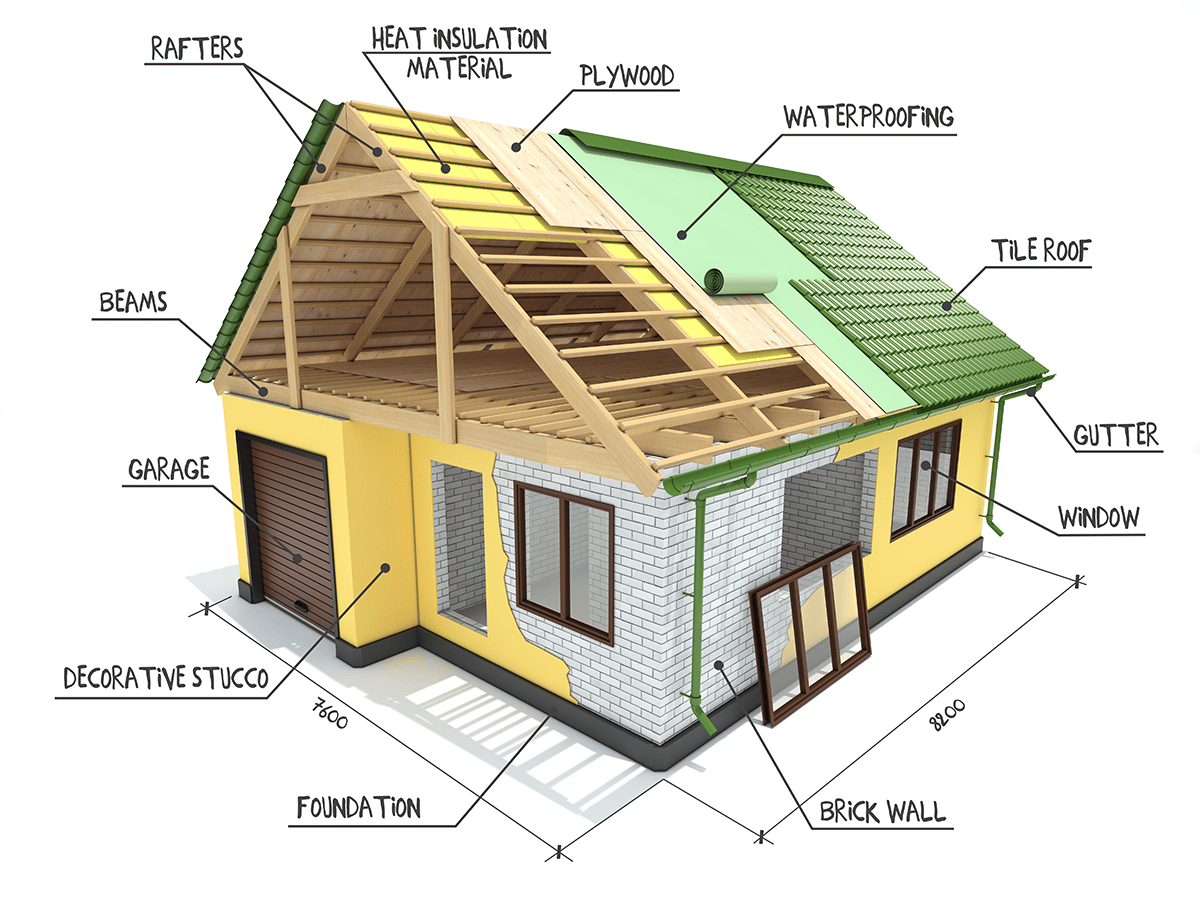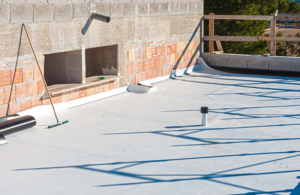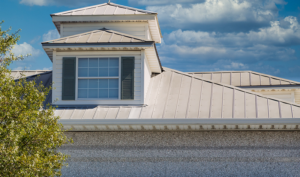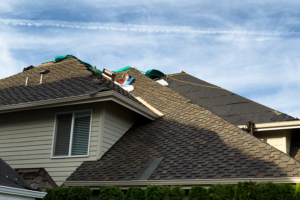A sturdy roof will protect you from rain, snow, wind, heat, cold, and general bad weather. A bad roof will leak and won’t maintain its integrity in the wind. The layers of a properly built roof are important to understand. The following list of roof parts are the major components of a complete roof and their functions in a modern home design.
What Is A Roof Truss?
This is the name for the overarching roof section that consists of many parts you will learn more about in this article. A “truss” is formed from several pieces, such as joists and ridge rafters. The truss supports the rafter, covering layer, sheathing, underlayment, insulation, and any other components that might be added to the roof, such as a skylight, chimney, and ventilation features. The angle of the truss over the rafter also determines the roof slope and attic space. Different roof types, specifically sloped roofs, and gable roofs, are more than one piece. Flat roofs have a completely different design.
What Is Roof Decking?
The roof deck is a generic term for different types of coverings that are nailed or secured down onto the rafters. They must be both lightweight and impervious to weather elements and water infiltration. Wood decking is the most common, but a solid decking board or a composite decking like oriented strand board (OSB) is also standard. The type of coverage will depend on many factors, such as cost, the weather where you live, and the kind of house. Green roofs, for example, are a variety with a sophisticated decking system and can have a complicated design because of the need for a more robust water protector from the waterproofing layer.
What are Roof Rafters?
Rafters run from one end to the other and form the roofing support system. Rafters are typically made from wood, as it is a robust and pliable material. Rafters can also be made from metal, especially in industrial buildings and high rises. The rafters support everything in the roofing structure, including the insulation and decking.
What is Fascia?
Fascia is a relatively superficial item that runs parallel to the ground along the edges. It is fixed to the rafters and may also serve as a support for the gutter. Fascia damage is an early indicator of possible problems at the edge of the roof.
What is A Roof Ridge?
A ridge is found on specific roof structures, including pitched, hipped roofs, gambrel, gabled roofs, and mansard roofs. For example, pitched, including hip roofs, is prevalent and found in many suburban houses. It forms the classic upside-down ‘V’ shape. The ridge is located at the highest point, where the two different sides intersect. The ridge is a point where two different continuous sections come together. Roof ridges have a gap, which is often fitted with ridge roof vents to provide ventilation.
What is A Roof Eave?
The eave is the lowest point on the roof surface. It is the point farthest away from the ridge in a pitched roof design—the area where water runoff from the roof edges makes it the best spot for the rain gutters. Depending on the type of roofing materials, this is also the last point with shingles, so it is often the point where shingles begin to peel off in a windstorm or deteriorate from water damage leading to rot. In cold weather, this area is where ice dams can form.
What Is A Roof Valley?
While not every house or building will have a valley, they are a common design element. The valley is the point of connection between two pitched sections. Because it is a valley, it is a natural place for rainwater, leaves, and other debris to collect. For that reason, many types of roofing valleys are equipped with flashing.
What Are Ceiling Joists?
Ceiling joists are almost always planks made of wood running along the rafters. They are used to improve the rafter’s strength and support the soffits like an arch, balcony, or eaves.
What Is A Soffit?
The soffit can be found between the wall, fascia, and eaves. A soffit conceals the rafters and ceiling joists. Its purpose is primarily to keep the elements out of your attic and to insulate the building. They also have some cosmetic use and making roofs and facings look complete.
What Is Roof Underlayment?
The underlayment consists of a waterproof material typically made out of a synthetic sheet, rubber strips, and felt. It is placed over the substructure or decking but under the shingles. The felt underlayment is usually found beneath the shingles, and it should be considered a part of the underlayment system. The underlayment’s job is to insulate the house from the elements, and the felt underlayment provides extra insulation. Because it is felt, you will find it placed underneath synthetic material to not get wet. Underlayment is another crucial layer in a total roof protection solution.
What Are Roof Battens?
The battens, also known as lath for roofing, are made from wooden or metal strips holding tiles and shingles in place. The spacing of the battens is essential to correctly and securely locate tiles and shingles. Battens are installed horizontally and, depending on the type, the spacing can vary.
What Are Shingles?
The shingles are the first barrier against the weather, so they must be tough and as weather-resistant as possible. Shingles are often made from a thick, tar-like product resistant to rot that can be nailed into place. The two most important considerations with shingles are weight and weather resistance. Some older homes may have wood shingles, slate, tile, or metal, but new generation fiberglass asphalt shingles are now the most common.
What Are Sky Lights And Sun Tunnels?
Skylights and Sun Tunnels are basically a window but at a flat angle. They allow the interior of a house to be illuminated with natural lighting. Their positions on the roof can make them much more likely to leak water. If you are considering a skylight, make sure that it is properly sealed and insulated.
What Are Flashings And Vent Pipes?
Flashing is a metal sheet made of either aluminum or galvanized steel. Flashing is used around the chimney, plumbing vents, valleys, and typically the drip edge. They seal the gap to prevent leaking and rot. These are a vital concern and require a periodic inspection from roofing professionals. Vent pipes are a form of attic ventilation used to help keep your home more energy efficient in the summer.
Is Attic Insulation Important?
Insulation is one of the more essential components. Most people know that a house or building is insulated, but fewer people think about roof insulation. Roof insulation is just as essential to protect the roof as the walls. If a roof has poor quality or missing insulation, it will lead to inadequate climate control and high energy bills.
What Gutters Are Best?
The gutter is the long basin that is attached to the eaves to catch water runoff. It is usually made from galvanized metal or plastic. Gutters need maintenance because leaves and debris get caught and clog the drainage. This will then cause the water to back up and overflow the gutter, potentially seeping into the roof and rotting the fascia and other wood components.
Long Term Care
It is pretty common for downspouts to become unmoored or plugged in bad storms, especially windstorms, and they should be checked regularly. You should also invest in high-quality gutters and inspect and clean them regularly. Failing to do this may leave you with clogged drains, a seeping roof, and rotting wood. Finally, have your roof inspected by a qualified contractor regularly to prevent more severe component failures in the future.
RESOURCES
Blue Nail Roofing has a Master Elite contractor status awarded by the largest roofing manufacturer in North America, GAF. Only 2% of contractors in the US meet the rigorous standards to achieve this status, which means you can be assured you are making a good choice when you select the professionals at Blue Nail to execute your home and business roofing repairs. Call today to schedule a professional evaluation!
Copyright © 2020 Blue Nail Enterprises. All rights reserved. | Privacy Policy
Let Us Nail Your Project!
Send us a little information about your roofing or home improvement needs and an expert will reach out shortly.







